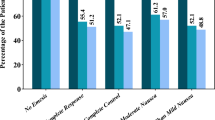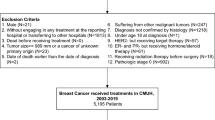Abstract
We aimed to investigate the association between rs3783553 polymorphism and susceptibility to epithelial ovarian cancer in a Chinese population and discussed the risk factors associated with survival time. In a case–control study, 301 patients diagnosed with epithelial ovarian cancer and 240 healthy controls were genotyped for rs3783553 polymorphism. Survival time of ovarian cancer patients was explored by Kaplan–Meier analysis and Cox proportional hazards modeling. The distributions of genotype and allele frequencies were significantly different between cases and controls. The variant homozygote (ins/ins) was associated with a significantly reduced risk of ovarian cancer. The patients with del/ins polymorphism seemed to be diagnosed “earlier” (FIGO stage I–II) and be more likely to achieve optimal cytoreductive surgery. Advanced FIGO stage (stages III–IV) and non-optimal cytoreductive surgery (residual tumor <1 cm) were poor prognostic factors in the univariate analysis. However, optimal cytoreductive surgery was found to be the only independent significant prognostic factor. This study suggests that rs3783553 polymorphism may be involved in the susceptibility to epithelial ovarian cancer. It may also be related with the tumor stage and the ability to achieve optimal tumor surgery, while the latter predicts the clinical outcomes for patients as the only independent prognostic factor.



Similar content being viewed by others
References
Siegel R, Naishadham D, Jemal A (2013) Cancer statistics, 2013. CA Cancer J Clin 63(1):11–30. doi:10.3322/caac.21166
Katsumata N, Yasuda M, Takahashi F, Isonishi S, Jobo T, Aoki D, Tsuda H, Sugiyama T, Kodama S, Kimura E, Ochiai K, Noda K (2009) Dose-dense paclitaxel once a week in combination with carboplatin every 3 weeks for advanced ovarian cancer: a phase 3, open-label, randomised controlled trial. Lancet 374(9698):1331–1338. doi:10.1016/S0140-6736(09)61157-0
Aghajanian C, Blank SV, Goff BA, Judson PL, Teneriello MG, Husain A, Sovak MA, Yi J, Nycum LR (2012) OCEANS: a randomized, double-blind, placebo-controlled phase III trial of chemotherapy with or without bevacizumab in patients with platinum-sensitive recurrent epithelial ovarian, primary peritoneal, or fallopian tube cancer. J Clin Oncol 30(17):2039–2045. doi:10.1200/JCO.2012.42.0505
Ali AY, Farrand L, Kim JY, Byun S, Suh JY, Lee HJ, Tsang BK (2012) Molecular determinants of ovarian cancer chemoresistance: new insights into an old conundrum. Ann N Y Acad Sci 1271:58–67. doi:10.1111/j.1749-6632.2012.06734.x
Xing D, Orsulic S (2005) A genetically defined mouse ovarian carcinoma model for the molecular characterization of pathway-targeted therapy and tumor resistance. Proc Natl Acad Sci USA 102(19):6936–6941. doi:10.1073/pnas.0502256102
Reade CJ, Riva JJ, Busse JW, Goldsmith CH, Elit L (2013) Risks and benefits of screening asymptomatic women for ovarian cancer: a systematic review and meta-analysis. Gynecol Oncol 130(3):674–681. doi:10.1016/j.ygyno.2013.06.029
Guo H, Ingolia NT, Weissman JS, Bartel DP (2010) Mammalian microRNAs predominantly act to decrease target mRNA levels. Nature 466(7308):835–840. doi:10.1038/nature09267
Yu Z, Li Z, Jolicoeur N, Zhang L, Fortin Y, Wang E, Wu M, Shen SH (2007) Aberrant allele frequencies of the SNPs located in microRNA target sites are potentially associated with human cancers. Nucl Acids Res 35(13):4535–4541. doi:10.1093/nar/gkm480
Jazdzewski K, Murray EL, Franssila K, Jarzab B, Schoenberg DR, de la Chapelle A (2008) Common SNP in pre-miR-146a decreases mature miR expression and predisposes to papillary thyroid carcinoma. Proc Natl Acad Sci USA 105(20):7269–7274. doi:10.1073/pnas.0802682105
Wu M, Jolicoeur N, Li Z, Zhang L, Fortin Y, L’Abbe D, Yu Z, Shen SH (2008) Genetic variations of microRNAs in human cancer and their effects on the expression of miRNAs. Carcinogenesis 29(9):1710–1716. doi:10.1093/carcin/bgn073
Nicklin MJ, Weith A, Duff GW (1994) A physical map of the region encompassing the human interleukin-1 alpha, interleukin-1 beta, and interleukin-1 receptor antagonist genes. Genomics 19(2):382–384. doi:10.1006/geno.1994.1076
Mustea A, Sehouli J, Konsgen D, Stengel D, Sofroni D, Lichtenegger W (2003) Interleukin 1 receptor antagonist (IL-1RA) polymorphism in women with cervical cancer. Anticancer Res 23(2A):1099–1102
Sehouli J, Mustea A, Koensgen D, Lichtenegger W (2003) Interleukin-1 receptor antagonist gene polymorphism in epithelial ovarian cancer. Cancer Epidemiol Biomark Prev 12(11 Pt 1):1205–1208
Lee KM, Park SK, Hamajima N, Tajima K, Choi JY, Noh DY, Ahn SH, Yoo KY, Hirvonen A, Kang D (2006) Genetic polymorphisms of interleukin-1 beta (IL-1B) and IL-1 receptor antagonist (IL-1RN) and breast cancer risk in Korean women. Breast Cancer Res Treat 96(2):197–202. doi:10.1007/s10549-005-9079-6
Gao Y, He Y, Ding J, Wu K, Hu B, Liu Y, Wu Y, Guo B, Shen Y, Landi D, Landi S, Zhou Y, Liu H (2009) An insertion/deletion polymorphism at miRNA-122-binding site in the interleukin-1α 3′ untranslated region confers risk for hepatocellular carcinoma. Carcinogenesis 30(12):2064–2069. doi:10.1093/carcin/bgp283
Yang ZH, Dai Q, Zhong L, Zhang X, Guo QX, Li SN (2011) Association of IL-1 polymorphisms and IL-1 serum levels with susceptibility to nasopharyngeal carcinoma. Mol Carcinog 50(3):208–214. doi:10.1002/mc.20706
Apte RN, Dotan S, Elkabets M, White MR, Reich E, Carmi Y, Song X, Dvozkin T, Krelin Y, Voronov E (2006) The involvement of IL-1 in tumorigenesis, tumor invasiveness, metastasis and tumor–host interactions. Cancer Metastasis Rev 25(3):387–408. doi:10.1007/s10555-006-9004-4
Gubbay O, Guo W, Rae MT, Niven D, Langdon SP, Hillier SG (2005) Inflammation-associated gene expression is altered between normal human ovarian surface epithelial cells and cell lines derived from ovarian adenocarcinomas. Br J Cancer 92(10):1927–1933. doi:10.1038/sj.bjc.6602568
Papacleovoulou G, Critchley HO, Hillier SG, Mason JI (2011) IL1alpha and IL4 signalling in human ovarian surface epithelial cells. J Endocrinol 211(3):273–283. doi:10.1530/JOE-11-0081
Rae MT, Niven D, Ross A, Forster T, Lathe R, Critchley HO, Ghazal P, Hillier SG (2004) Steroid signalling in human ovarian surface epithelial cells: the response to interleukin-1α determined by microarray analysis. J Endocrinol 183(1):19–28. doi:10.1677/joe.1.05754
Keita M, Bessette P, Pelmus M, Ainmelk Y, Aris A (2010) Expression of interleukin-1 (IL-1) ligands system in the most common endometriosis-associated ovarian cancer subtypes. J Ovarian Res 3:3. doi:10.1186/1757-2215-3-3
Frede S, Freitag P, Otto T, Heilmaier C, Fandrey J (2005) The proinflammatory cytokine interleukin 1β and hypoxia cooperatively induce the expression of adrenomedullin in ovarian carcinoma cells through hypoxia inducible factor 1 activation. Cancer Res 65(11):4690–4697. doi:10.1158/0008-5472.CAN-04-3877
Ioana Braicu E, Mustea A, Toliat MR, Pirvulescu C, Konsgen D, Sun P, Nurnberg P, Lichtenegger W, Sehouli J (2007) Polymorphism of IL-1α, IL-1β and IL-10 in patients with advanced ovarian cancer: results of a prospective study with 147 patients. Gynecol Oncol 104(3):680–685. doi:10.1016/j.ygyno.2006.10.014
Santtila S, Savinainen K, Hurme M (1998) Presence of the IL-1RA allele 2 (IL1RN*2) is associated with enhanced IL-1β production in vitro. Scand J Immunol 47(3):195–198
Zeng XF, Li J, Li SB (2013) A functional polymorphism in IL-1A gene is associated with a reduced risk of gastric cancer. Tumour Biol. doi:10.1007/s13277-013-1034-2
Tingulstad S, Skjeldestad FE, Halvorsen TB, Hagen B (2003) Survival and prognostic factors in patients with ovarian cancer. Obstet Gynecol 101(5 Pt 1):885–891
Acknowledgments
This study was supported by The National Natural Science Foundation Grants of China (No. 81172494).
Conflict of interest
The authors have no conflict of interest.
Ethical standard
This study was performed with the approval of the Medical Ethical Review Committee of West China Second University Hospital of Sichuan University, and informed consent was obtained from all of the participants.
Author information
Authors and Affiliations
Corresponding authors
Additional information
Zhu Zhang, Bin Zhou, Qianqian Gao, Yuke Wu, Yaping Song, Lin Zhang and Mingrong Xi have contributed equally to the work and each is considered first author.
Zhu Zhang and Bin Zhou have contributed equally to the work.
Rights and permissions
About this article
Cite this article
Zhang, Z., Zhou, B., Gao, Q. et al. A polymorphism at miRNA-122-binding site in the IL-1α 3′UTR is associated with risk of epithelial ovarian cancer. Familial Cancer 13, 595–601 (2014). https://doi.org/10.1007/s10689-014-9739-y
Published:
Issue Date:
DOI: https://doi.org/10.1007/s10689-014-9739-y




